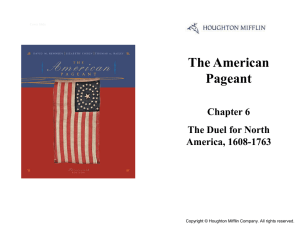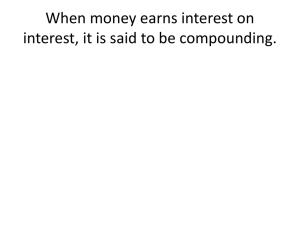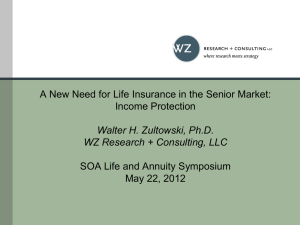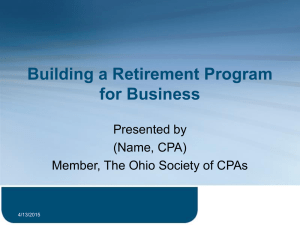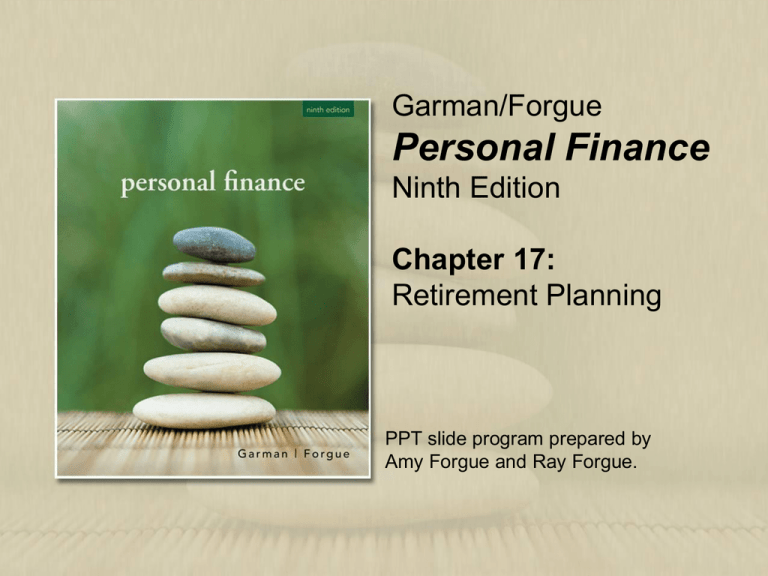
Garman/Forgue
Personal Finance
Ninth Edition
Chapter 17:
Retirement Planning
PPT slide program prepared by
Amy Forgue and Ray Forgue.
Learning Objectives
1. Recognize that you are solely
responsible for funding your retirement
and must sacrifice some current
spending and invest for your future
lifestyle.
2. Estimate your Social Security
retirement income benefit.
Copyright ©Houghton Mifflin Company. All rights reserved.
17 - 2
Learning Objectives
3. Calculate your estimated retirement
savings needs in today’s dollars.
4. Understand why you should save for
retirement within tax-sheltered
retirement accounts.
5. Distinguish among the types of
employer-sponsored retirement plans.
Copyright ©Houghton Mifflin Company. All rights reserved.
17 - 3
Learning Objectives
6. Explain the values of the various types of
personally established tax-sheltered
retirement accounts
7. Recognize that professional investment
advice for retirement assets is available,
including Monte Carlo simulations.
8. Describe techniques for living in retirement
without running out of money.
Copyright ©Houghton Mifflin Company. All rights reserved.
17 - 4
Retirement Planning Is Your
Responsibility
• Retirement: The time in life when the
major sources of income changed from
earned income to employer-based
retirement benefits, private savings and
investments, Social Security, etc.
Copyright ©Houghton Mifflin Company. All rights reserved.
17 - 5
Understanding Your Social Security
Retirement Income Benefits
• FICA Taxes: Social Security taxes
withheld from wages.
• Your contributions to Social Security
and Medicare: taken out of maximum
taxable yearly earnings (or MTYE)
Copyright ©Houghton Mifflin Company. All rights reserved.
17 - 6
Understanding Your Social Security
Retirement Income Benefits
• How you can become qualified for
Social Security benefits:
– Social Security Credits
– Being fully insured requires 40 credits.
– You are currently insured if you have
earned 6 credits in the most recent 3
years.
Copyright ©Houghton Mifflin Company. All rights reserved.
17 - 7
Understanding Your Social Security
Retirement Income Benefits
• How you can become qualified for
Social Security benefits:
– Traditionally insured: retired workers who
reach age 72 without accumulating 40
credits
– Worker younger than 72 who have not
accumulated 6 credits are not insured.
Copyright ©Houghton Mifflin Company. All rights reserved.
17 - 8
How to Estimate Your Social Security
Retirement Benefits
• Indexing: adjusting earnings to account
for changes in wages since the year the
earnings were received.
• Basic Retirement Benefit (or Primary
Insurance Amount)
• Full-benefit retirement age: 67 for
those born after 1960
Copyright ©Houghton Mifflin Company. All rights reserved.
17 - 9
How to Estimate Your Social Security
Retirement Benefits
1. Begin receiving benefit at your fullbenefit age.
2. Begin receiving reduced benefits at a
younger age.
3. Begin receiving larger benefits at a
larger age.
Copyright ©Houghton Mifflin Company. All rights reserved.
17 - 10
How to Estimate Your Social Security
Retirement Benefits
• Check the accuracy of your Social
Security statement.
Copyright ©Houghton Mifflin Company. All rights reserved.
17 - 11
How to Calculate Your Estimated
Retirement Needs in Today’s Dollars
• Retirement Savings Goal (or
Retirement Nest Egg)
• Projecting your annual retirement
expenses and income.
– Expenses
– Current nest egg
– Do you have greater current deposits?
– Additional deposits needed
Copyright ©Houghton Mifflin Company. All rights reserved.
17 - 12
Why Invest in Tax-Sheltered Retirement
Accounts?
• Funds put into regular investment
accounts are after-tax money.
• A tax-sheltered retirement accounts
is one for which contributions are not
subject to income taxes.
Copyright ©Houghton Mifflin Company. All rights reserved.
17 - 13
Why Invest in Tax-Sheltered Retirement
Accounts?
• Your contributions may be tax
deductible, i.e. pretax money.
• Your earnings are tax deferred.
• You can accumulate more money.
Copyright ©Houghton Mifflin Company. All rights reserved.
17 - 14
Why Invest in Tax-Sheltered Retirement
Accounts?
• You have ownership and portability.
• You withdrawals might be tax free, i.e.
withdrawals are never taxed.
Copyright ©Houghton Mifflin Company. All rights reserved.
17 - 15
Employer-Sponsored Retirement Plans
• Employer-sponsored retirement plan
(or Qualified Plan)
• Employee retirement income security
act (or ERISA)
Copyright ©Houghton Mifflin Company. All rights reserved.
17 - 16
Employer-Sponsored Retirement Plans
• Defined-contribution retirement plan:
today’s standard
• It is a self directed, noncontributory
plan. Contributory plans accept
employee and employer contributions.
• Can potentially be an automatic
enrollment plan.
Copyright ©Houghton Mifflin Company. All rights reserved.
17 - 17
Employer-Sponsored Retirement Plans
• Names of defied-contribution retirement
plans:
– 401(k) Plan
– 403(b) Plan
– 457 Plan
– Savings Incentive Match Plan for
Employees IRA (SIMPLE IRA)
Copyright ©Houghton Mifflin Company. All rights reserved.
17 - 18
Employer-Sponsored Retirement Plans
• Matching contributions: employers
fully or partially match employee
contributions
• Limits on contributions: $15500 for
401(k), 403(b), and 457; $10500 for
SIMPLE IRAs
Copyright ©Houghton Mifflin Company. All rights reserved.
17 - 19
Employer-Sponsored Retirement Plans
• Catch-up provision: Workers over the
age of 50 can contribute and extra
$5000 to retirement plan.
• Vesting gives you rights to your
benefits.
– Cliff vesting, graduated vesting
Copyright ©Houghton Mifflin Company. All rights reserved.
17 - 20
Employer-Sponsored Retirement Plans
• Retirement plan contribution tax credit
for low-income and moderate-income
savers.
• For singles with adjusted gross incomes
of less the $25000 and joint filers with
adjusted gross incomes less than
$50000.
Copyright ©Houghton Mifflin Company. All rights reserved.
17 - 21
Employer-Sponsored Retirement Plans
• Defined-benefit retirement plan:
yesterday’s standard
• A.K.A. Pension
Copyright ©Houghton Mifflin Company. All rights reserved.
17 - 22
How to Avoid Rollover Penalties When
Changing Employers or Retiring
• Leave it, transfer it to a retirement account
with new employer, transfer it to an IRA,
take it in cash.
• Options 2-4 result a rollover penalty.
• Avoid the 20 Percent Withholding Rule
by using a trustee-to-trustee rollover.
Copyright ©Houghton Mifflin Company. All rights reserved.
17 - 23
Employer-Sponsored Retirement Plans
• Normal or early retirement?
• Disability and survivors benefits
Copyright ©Houghton Mifflin Company. All rights reserved.
17 - 24
Additional Employer-Sponsored Plans
•
Employee stock-ownership plan (or
ESOP)
•
Profit-sharing plan
Copyright ©Houghton Mifflin Company. All rights reserved.
17 - 25
You Can Also Contribute to Personal
Retirement Accounts
• Individual Retirement Account (or IRA)
• Traditional (or regular) IRA
• Roth IRAs
• Keoghs and Simplified Employee PensionIndividual Retirement Account (SEP-IRAs)
Copyright ©Houghton Mifflin Company. All rights reserved.
17 - 26
Use Financial Advice and Monte Carlo
Simulations
• When starting out, try investing in a lowfee target-date retirement fund.
• Use Monte Carlo simulations to help
guide retirement investment decisions.
Copyright ©Houghton Mifflin Company. All rights reserved.
17 - 27
Living in Retirement Without Running
Out of Money
• Figure out how many years your money
will last in retirement and make monthly
withdrawals accordingly.
• Buy an annuity (or immediate annuity)
and receive monthly checks.
– There are immediate, deferred, and
variable annuities.
– Often offered by employers
Copyright ©Houghton Mifflin Company. All rights reserved.
17 - 28
Living in Retirement Without Running
Out of Money
What retirement money to spend first:
1. Taxable Assets
2. Tax-Deferred Assets
3. Tax-Free Assets
Copyright ©Houghton Mifflin Company. All rights reserved.
17 - 29
The Top 3 Financial Missteps In
Retirement Planning
People slip up in investing in retirement
planning when they do the following:
1. Never start to save for retirement.
2. Put away too little money.
3. Use high-expense mutual funds for
your 401(k) or IRA accounts.
Copyright ©Houghton Mifflin Company. All rights reserved.
17 - 30
Good Money Habits in Retirement
Planning
• Save early and often by beginning
early in life to invest in mutual funds
through tax-sheltered retirement
accounts and continuing to invest
every year.
• Take enough risk to increase the
likelihood that you will have enough
money in retirement.
Copyright ©Houghton Mifflin Company. All rights reserved.
17 - 31
Good Money Habits in Retirement
Planning
•
Save within an employer-sponsored
retirement plan at least the amount
required to obtain the full matching
contribution from your employer.
•
Diversify your investments and limit
company stock to no more than 10
percent of your portfolio.
Copyright ©Houghton Mifflin Company. All rights reserved.
17 - 32
Good Money Habits in Retirement
Planning
• Contribute to Roth IRA and traditional
IRA accounts to supplement your
employer-sponsored plans.
• Keep your hands off your retirement
money. Do not borrow it. Do not
withdraw it. When charging employers,
roll over the funds into the new
employer’s plan or a rollover IRA.
Copyright ©Houghton Mifflin Company. All rights reserved.
17 - 33



